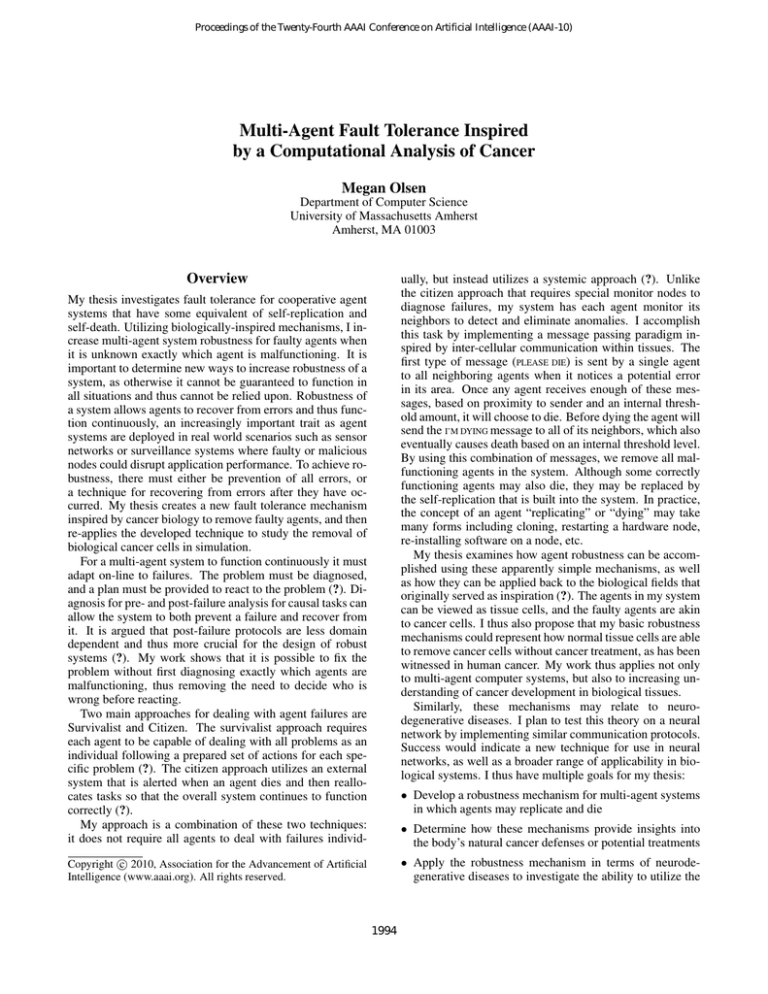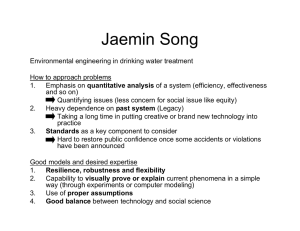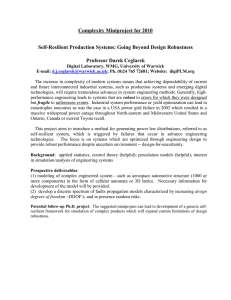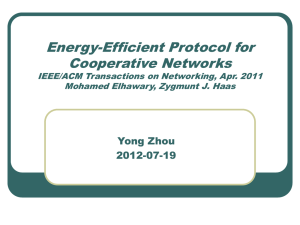
Proceedings of the Twenty-Fourth AAAI Conference on Artificial Intelligence (AAAI-10)
Multi-Agent Fault Tolerance Inspired
by a Computational Analysis of Cancer
Megan Olsen
Department of Computer Science
University of Massachusetts Amherst
Amherst, MA 01003
Overview
ually, but instead utilizes a systemic approach (?). Unlike
the citizen approach that requires special monitor nodes to
diagnose failures, my system has each agent monitor its
neighbors to detect and eliminate anomalies. I accomplish
this task by implementing a message passing paradigm inspired by inter-cellular communication within tissues. The
first type of message (PLEASE DIE) is sent by a single agent
to all neighboring agents when it notices a potential error
in its area. Once any agent receives enough of these messages, based on proximity to sender and an internal threshold amount, it will choose to die. Before dying the agent will
send the I’M DYING message to all of its neighbors, which also
eventually causes death based on an internal threshold level.
By using this combination of messages, we remove all malfunctioning agents in the system. Although some correctly
functioning agents may also die, they may be replaced by
the self-replication that is built into the system. In practice,
the concept of an agent “replicating” or “dying” may take
many forms including cloning, restarting a hardware node,
re-installing software on a node, etc.
My thesis examines how agent robustness can be accomplished using these apparently simple mechanisms, as well
as how they can be applied back to the biological fields that
originally served as inspiration (?). The agents in my system
can be viewed as tissue cells, and the faulty agents are akin
to cancer cells. I thus also propose that my basic robustness
mechanisms could represent how normal tissue cells are able
to remove cancer cells without cancer treatment, as has been
witnessed in human cancer. My work thus applies not only
to multi-agent computer systems, but also to increasing understanding of cancer development in biological tissues.
Similarly, these mechanisms may relate to neurodegenerative diseases. I plan to test this theory on a neural
network by implementing similar communication protocols.
Success would indicate a new technique for use in neural
networks, as well as a broader range of applicability in biological systems. I thus have multiple goals for my thesis:
My thesis investigates fault tolerance for cooperative agent
systems that have some equivalent of self-replication and
self-death. Utilizing biologically-inspired mechanisms, I increase multi-agent system robustness for faulty agents when
it is unknown exactly which agent is malfunctioning. It is
important to determine new ways to increase robustness of a
system, as otherwise it cannot be guaranteed to function in
all situations and thus cannot be relied upon. Robustness of
a system allows agents to recover from errors and thus function continuously, an increasingly important trait as agent
systems are deployed in real world scenarios such as sensor
networks or surveillance systems where faulty or malicious
nodes could disrupt application performance. To achieve robustness, there must either be prevention of all errors, or
a technique for recovering from errors after they have occurred. My thesis creates a new fault tolerance mechanism
inspired by cancer biology to remove faulty agents, and then
re-applies the developed technique to study the removal of
biological cancer cells in simulation.
For a multi-agent system to function continuously it must
adapt on-line to failures. The problem must be diagnosed,
and a plan must be provided to react to the problem (?). Diagnosis for pre- and post-failure analysis for causal tasks can
allow the system to both prevent a failure and recover from
it. It is argued that post-failure protocols are less domain
dependent and thus more crucial for the design of robust
systems (?). My work shows that it is possible to fix the
problem without first diagnosing exactly which agents are
malfunctioning, thus removing the need to decide who is
wrong before reacting.
Two main approaches for dealing with agent failures are
Survivalist and Citizen. The survivalist approach requires
each agent to be capable of dealing with all problems as an
individual following a prepared set of actions for each specific problem (?). The citizen approach utilizes an external
system that is alerted when an agent dies and then reallocates tasks so that the overall system continues to function
correctly (?).
My approach is a combination of these two techniques:
it does not require all agents to deal with failures individ-
• Develop a robustness mechanism for multi-agent systems
in which agents may replicate and die
• Determine how these mechanisms provide insights into
the body’s natural cancer defenses or potential treatments
• Apply the robustness mechanism in terms of neurodegenerative diseases to investigate the ability to utilize the
c 2010, Association for the Advancement of Artificial
Copyright Intelligence (www.aaai.org). All rights reserved.
1994
mechanisms in neural networks
Results So Far
I have primarily tested this system using a simulation of selfreplicating, self-dying, and self-organizing agents in a 3D
world. Correctly functioning agents will only be created in
the neighborhood of another correctly functioning agent if
there is room for it, and will only occur when the probability
of replication allows it. Malfunctioning agents will however
be created at a more frequent rate once a single agent has
begun to malfunction. The system is tested starting at the
point where an agent begins to malfunction.
I have tested my system with hundreds of agent parameters in combination with hundreds of robustness protocol
parameter sets. I focus on worst case scenario parameters,
in which faulty agents malfunction in such a way as to increase their likelihood of overrunning the system. I consider
success to be represented by removing all malfunctioning
agents without removing the majority of correctly functioning agents in the majority of experiments run for a specific
set of parameters. My most recent results (not yet published)
show that in the majority of cases we are able to remove the
malfunctioning agents completely without also removing a
majority of the correctly functioning agents. This can be
accomplished whether the rate of malfunctioning agent creation is close to the rate of normal agent creation or significantly higher. I include in my experiments parameter
sets in which malfunctioning agents need to receive many
more PLEASE DIE and I’M DYING messages to die. This demonstrates that my robustness mechanism is able to effectively
prevent system failure in a range of scenarios, even when
faulty agents are partially resistant to the recovery protocols.
In addition, I have incorporated a possibility of the robustness protocols failing. In these cases, either malfunctioning agents may not always send I’M DYING messages before they die from the protocols, or they may sometimes ignore received messages. As seen in Figure 1, even when
malfunctioning agents fail to acknowledge my robustness
mechanisms the majority of the time, my mechanisms can
still succeed in removing them from the system before all
normal agents are also destroyed.
I have also analyzed the basic system mathematically using differential equations, as well as from the view of a cellular automata. These forms of analysis are currently most
useful for the analogous cancer model, and we have found
similar promising results when using biologically plausible
data with our robustness mechanisms. It is possible that the
mechanisms we propose will help cancer researchers understand related biological phenomenon that are currently unexplained.
Figure 1: When agents may ignore robustness messages
(diamond) or fail to send I’M DYING messages before dying
(square), we still see high success rates. For up to 60% failure rates for either failure, we still see 100% success in systems were the correctly functioning robustness protocol also
succeeded 100% of the time. The system cannot handle either failure occuring more than 80% of the time. However,
these results show that my robustness mechanism is robust
to failures within itself.
2. Continue developing a mechanism that can be easily applied to many computer systems.
3. Develop the neural network model of neuro-degenerative
diseases. This project is a focus of the spring 2010
semester, and should be finished by the DC.
Work Plan
I plan to continue the multi-agent robustness investigation,
as well as increasing the work on the biological analogies
to be applied to human cells in regards to cancer and neurodegenerative diseases:
1. Add additional biological details such as blood vessels to
increase the biological plausibility of the cancer model.
1995






